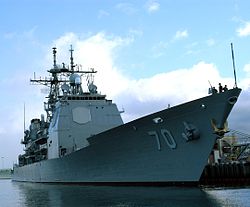
| Ships of the United States Navy | |
|---|---|
 | |
| Ships in current service | |
| Ships grouped alphabetically | |
| Ships grouped by type | |
This list of cruisers of the United States Navy includes all ships that were ever called "cruiser", either publicly or in internal documentation.
Contents
- Historical overview
- Nomenclature
- Overview of hull classifications
- Hull reclassifications and skipped hull numbers
- Cruisers without hull designations
- First cruisers
- Armed merchant cruisers
- German war prize
- Armored cruisers (ACR)
- Protected and Peace cruisers (C, PG)
- Cruiser minelayers (CM)
- Scout cruisers (SCR, SC, CS)
- Battlecruisers (CC)
- Heavy and light cruisers (CA, CL)
- Post-World War I
- Washington Naval Treaty
- London Naval Treaty
- Second London Naval Treaty
- Early World War II
- Late World War II
- Post-World War II
- Large cruisers (CB)
- German cruiser war prize (IX)
- Hunter-Killer cruisers (CLK)
- Antiaircraft cruisers (CLAA)
- Command cruisers (CLC, CC)
- Guided missile cruisers (CAG, CLG, CG)
- 'Cruiser hulls'
- 'Destroyer hulls'
- Nuclear-powered cruisers (CGN)
- Miscellaneous lists
- List by name
- List of unnamed cruisers by hull number
- List of canceled cruiser conversions
- List of skipped cruiser hull numbers
- See also
- References
- Footnotes
- Citations
- General and cited sources
- External links
The Navy has 9 Ticonderoga-class cruisers in active service, as of 10 October 2024, with the last tentatively scheduled for decommissioning in 2029. [1] With the cancellation of the CG(X) program in 2010, the Navy currently has no cruiser replacement program planned. [2] The Navy is looking to the Aegis-equipped Arleigh Burke-class destroyers to increasingly fill the role of the cruiser in the protection of the carrier strike group, as it could be well into the 2030s before any possible cruiser replacement program is up and running. [2]
Ship status is indicated as either currently active [A] (including ready reserve), inactive [I], or precommissioning [P]. Ships in the inactive category include only ships in the inactive reserve, ships which have been disposed from US service have no listed status. Ships in the precommissioning category would include ships under construction or on order; as described above there currently are no such cruisers.
















































